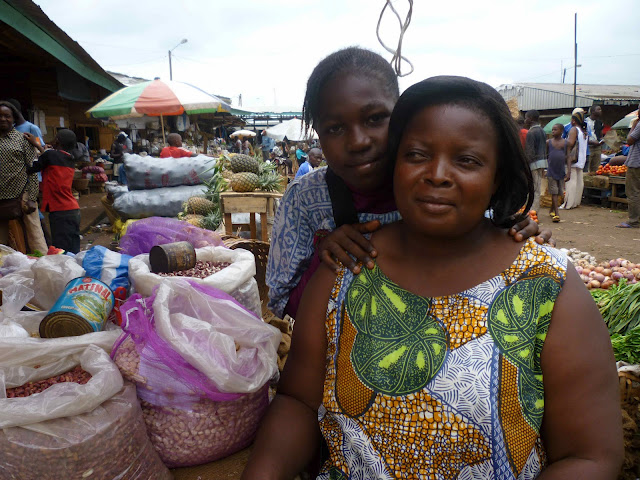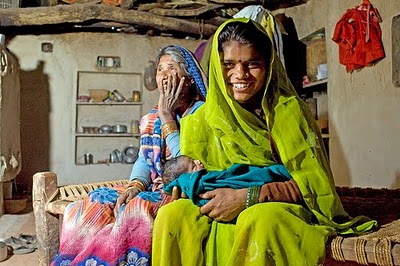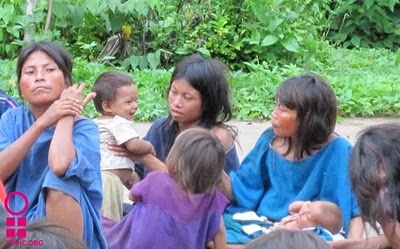-
How Maternal Mortality and Morbidity Impact Economic Development
›“Investing in women and girls is the right thing to do,” says Mayra Buvinic, sector director of the World Bank’s gender and development group. “It is not only fair for gender equality, but it is smart economics.” But while it may be smart economics, many developing countries fail to address the underlying social causes that impact economic growth, such as poverty and gender inequality. Buvinic was joined by Dr. Nomonde Xundu, health attaché at the Embassy of South Africa in Washington, D.C., and Mary Ellen Stanton, senior maternal health advisor at the U.S. Agency for International Development (USAID), at the sixth meeting of the Advancing Policy Dialogue on Maternal Health Series, which addressed the economic impact of maternal mortality and provided evidence for the need for increased investment in maternal health.
-
Women Deliver: Real Solutions for Reproductive Health and Maternal Mortality
›The landmark Women Deliver conference, which concluded last week, reinvigorated the global health community’s commitment to improve reproductive health at both the grassroots and global levels. Providing a major boost was the Gates Foundation’s announcement that it will commit an additional $1.5 billion over the next five years to support maternal and child health, family planning, and nutrition programs in developing countries.
“We haven’t tried hard enough,” said Gates Foundation co-founder Melinda Gates. “Most maternal and newborn deaths can be prevented with existing, low-cost solutions.” Examples of these efficient and effective solutions were presented at the three-day conference’s dozens of panels on a wide range of issues, including climate change, contraceptive commodities, fistula, gender inequities, adolescent family planning, communications and technology, and much more.
Empowering Young Girls to Access Family Planning
“When we speak about adolescents we typically think of prevention. However, we must also think about providing access to safe abortions and supporting young women who want to be mothers and empower young women to make choices,” said Katie Chau, a consultant at International Planned Parenthood Federation.
In Nigeria, “there is not much attention on adolescent sexual and reproductive health, even though a majority of rapes occur before the age of 13, and the rate of teenage pregnancy and abortions is high,” said Bene Madunagu, chair of the Girls’ Power Initiative (GPI) in Nigeria. GPI teaches girls about their rights to make decisions, including those regarding sex and reproductive health, as well as improving their critical thinking skills, self-esteem, and body image. “Girls develop critical consciousness and question discriminatory practices, while also learning about the legal instruments to take up their concerns,” he said.
Sadaf Nasim of Rahnuma Family Planning said child marriages are common in his country, Pakistan. “Marriage is an easy solution for poor families. Once a girl is married she is no longer the responsibility of the family,” he explained.
While laws in Pakistan and other parts of the developing world condemn child marriage, the prevalence of child marriage remains high: 49 percent of girls are married by age 18 in South Asia, and 44 percent in West and Central Africa. Nasim said birth registration at the local and national levels should be improved to prevent parents from manipulating their daughter’s age.
In Kyrgyzstan, “community-based efforts worked to galvanize media attention and disseminate information to demonstrate the need for improved adolescent family planning,” said Tatiana Popovitskaya, a project coordinator with Reproductive Health Alliance of Kyrgyzstan. Such community-based approaches use grassroots education to mobilize community leaders, which is a critical step in overcoming child marriage and other harmful traditions.
Cell Phones and Maternal Health
“There is a lot of information being collected, but it is not necessarily going where it needs to because of fragmentation,” said Alison Bloch, program director at mHealth Alliance. In developing countries, the people most in need are often the most isolated, but mobile technology is emerging as a way to bridge the gaps.
According to a recent report by mHealth Alliance, 64 percent of mobile phone users live in developing countries and more than half of people living in remote areas will have mobile phones by 2012. The potential for improving global health with cell phones and PDAs is significant, and can address a wide range of health issues, such as human resource shortages and information sharing problems between clinics and hospitals.
“Mobile technology provides benefits to individuals, institutions, caregivers, and the community. It reduces travel time and costs for the individual, improves efficiency of health service delivery, and streamlines information to health workers to reduce maternal mortality,” said Elaine Weidman, vice president of sustainability and corporate responsibility at Ericsson.
“Mobile technology is the most rapidly adopted technology in history and represents an existing opportunity to reach the un-reached,” said Fabiano Teixeira da Cruz, a program manager for the Inter-American Development Bank, speaking of the benefits of using mobile technology to train field-based healthcare workers in Latin America.
While mobile phones are indeed reaching parts of the world not currently equipped with quality healthcare, the lack of systematic coordination and infrastructure at the district and regional levels must also be addressed, as highlighted during a recent Wilson Center event, Improving Transportation and Referral for Maternal Health.
Read about our first impressions of Women Deliver 2010 here.
Calyn Ostrowski is program associate with the Wilson Center’s Global Health Initiative
Photo credit: Woman and child in South African AIDS clinic, courtesy Flickr user tcd123usa. -
Improving Transportation and Referral for Maternal Health
›“Referral has been called an orphan cause,” said Patricia Bailey, public health specialist for Family Health International and Columbia University, because it is “everybody’s responsibility and therefore nobody’s responsibility.”
As part of the Maternal Health Dialogue Series the Woodrow Wilson International Center for Scholars’ Global Health Initiative convened a small technical meeting on May 19, 2010, with 25 experts from five countries to discuss their experiences and share lessons, challenges, and recommendations for improving transportation and referral for maternal health. Following the technical meeting, a public dialogue was held on May 20, 2010, to share the knowledge gaps and recommendations identified. The formal report from the technical meeting will be available in the near future.
Mobilizing District Communities in Rural Ghana
To improve maternal health care in Ghana, “we needed to shift [services] to the community level, where 70 percent of our population lives,” said Dr. John Koku Awoonor-Williams, the east regional director of Ghana Health Service. The “Community-based Health Planning and Services” (CHPS) program was created to galvanize local leadership and empower communities to engage in health outreach activities.
Through this approach, “community health officers and nurses are trained and delegated to distant village locations called CH[I]P zones, in which they are responsible for health education, treatment of minor illnesses, maternal and antenatal care, and referral to district hospitals for emergency care,” said Awoonor-Williams. Community health officers use two-way Motorola walkie-talkies to communicate with traditional birth attendants and referral centers. Pregnant women are given the phone numbers so they can call in the event of complications.
1-0-8 Emergency Number for Improving Maternal Health in India
Many parts of the developing world do not have a 911-style emergency response service. To address this gap, the GVK Emergency Management & Research Institute in India developed the toll-free 1-0-8 telephone number for all medical, police, and fire emergencies.
“We assure every citizen that wherever you are, [if] you call us we will be there,” said Subodh Satyawadi, chief operating officer of GVK. In order to reach the 433 million people covered by GVK, they have:
“Although we address all kinds of emergencies, we heavily focus on maternal health…31 percent of emergencies are pregnancy-related,” said Satyawadi, who said that GVK’s emergency response system has helped save more than 200,000 mothers. Institutional deliveries have increased in the state of Gujarat by 92 percent. “We have been able to reduce maternal mortality by 20-25 percent in different geographies,” he said.- 19,623 EMTs and 10,000 doctors and other healthcare professionals
- 2,710 ambulances
- 16,300 call-center employees
Pre-Hospital Barriers: Reducing Maternal Morbidity in Bolivia
Women in Bolivia receive free maternal care. In cities like La Paz, emergency obstetric care is often available within a short distance. However, “37 percent of our maternal deaths [occur] at our hospitals,” said Víctor Conde Altamirano, OB/GYN of CARE Bolivia.
To better understand this mortality rate, Altamirano evaluated whether pre-hospital barriers and routine antenatal care are associated with near-miss morbidity. He found that women who are older, have lower levels of education, lack antenatal care, are pregnant for the first time, or live in rural areas are at a greatest risk of illness or death
“We are trying to organize our communities and service facilities, and promote improved health management by the municipalities. If our authorities can be sensitive and invest in health; invest in fuel, drugs, and human resources; we can improve near-miss morbidity rates,” said Altamirano.
Strategies and Recommendations for Improving Transportation & Referral
The workshop participants agreed on six key topic areas for improving transportation and referral:1. Multi-sectoral collaboration
The group called for improved multi-sectoral engagement and continuous dialogue among key ministries: Health, Finance, Communication, Social Welfare, Security and Defense, Transportation, and Public Works.
2. Mobile phone technology
3. Public-private partnerships
4. Referral for newborns
5. Indicators for referral
6. Sharing evidence
Private-public partnerships, such as those demonstrated by GVK in India and the CH[I]P program in Ghana, create opportunities for collaboration. “Cell-phone technology can reduce delays in transport and treatment by identifying which facilities might be the most appropriate for referral,” said Bailey.
The final recommendation by the group calls for increased pooling and use of existing evidence to move the transportation and referral agenda forward. Updated synthesis papers on existing evidence are needed, said Bailey. “We have a lot of data that is perhaps less than perfect, but this should not be a barrier for further action,” she said. -
New Maternal Mortality Statistics: A Catalyst for Increased Investment
›Maternal mortality rates in many low income countries, such as India, are declining, according to a recent study by researchers at the Institute of Health Metrics and Evaluation (IHME) at the University of Washington. According to the report, maternal deaths have fallen from 526,000 a year in 1980 to 342,900 in 2008. This news, while welcoming, has caused dissent among some global health activists who fear donors and policymakers will dismiss the issue and call into question the higher maternal mortality rates last reported by the United Nations. While concerns over monitoring and evaluation raise important methodology questions, this news must also serve as catalyst for world leaders and donors to take action and recognize that investing in women pays.
The data reported by IHME only concludes what maternal health advocates already know. “We know how to save women’s lives, we don’t need a cure…this is a political problem and political will is essential,” said Theresa Shaver, director of White Ribbon Alliance, at a Wilson Center event in December 2008. Greater funding for family planning and access to emergency obstetric care and HIV/AIDS services should all be included in a scaling up resources for improved maternal health programs. “Without HIV, annual maternal deaths would have been 281,500 in 2008,” said Richard Horton, editor of The Lancet, in last week’s Lancet comments.
Investing in contraception and family planning services through vertical funding mechanisms can reduce maternal mortality rates by addressing all of a woman’s health needs at the time of service. To widen the platform of comprehensive services for women and their families, efforts to link public health services and offer more at one location should be expanded. “Many women have expressed a need for contraception and family planning services…when you offer family planning services on-site with HIV services, you have a huge uptake in family planning use,” shared Michelle Moloney-Kitts, assistant coordinator at the Office of the U.S. Global AIDS Coordinator at a the Wilson Center in December 2009.
Yet political will remains in short supply. “Despite strong advocacy efforts, political leaders have either ignored the call or failed to make the health of women in pregnancy a priority,” stated Horton. Six countries–Afghanistan, Democratic Republic of Congo, Ethiopia, India, Nigeria, and Pakistan–account for over half of all maternal deaths worldwide, and increased investment in these countries will improve maternal health targets, such as Millennium Development Goal (MDG) 5 seeking to reduce maternal deaths by 75 percent.
Progress is possible and “policymakers are more likely to act on issues that they think they can do something about,” said Jeremy Shiffman, associate professor of public administration at Syracuse University, at the Wilson Center in March 2009. The maternal health community must rally around these positive findings and galvanize support for greater financial contributions. “Two decades of concerted campaigning by those dedicated to maternal health is working,” said Horton.” “[G]reater investment in that work is likely to deliver even greater benefits.”
Calyn Ostrowski is the program associate for the Wilson Center’s Global Health Initiative.
Photo Credits: A woman in India safely delivers her baby in the hospital through the Madhya Pradesh Health Sector Reform program. Courtesy Flickr user Department for International Development -
Family Planning in Fragile States
›
“Conflict-affected countries have some of the worst reproductive health indicators,” said Saundra Krause of the Women’s Refugee Commission at a recent Wilson Center event. “Pregnant women may deliver on the roadside or in makeshift shelters, no longer able to access whatever delivery plans they had. People fleeing their homes may have forgotten or left behind condoms and birth control methods.”
-
Maternal Health Solutions in Peru
›Media reports on the neglected discussion of maternal and child health often focus on the problems and projects in sub-Saharan Africa or South Asia, which is understandable, as a disproportionate 90 percent of global maternal deaths occur in these two regions. Last month, however, PBS correspondent Ray Suarez reminded us that maternal and child mortality affects countries all over the world, including Peru, where “maternal death rates has historically been unusually high,” he noted in a report for NewsHour.
“Few people in the highlands of central Peru own automobiles and it’s hard to know exactly when the next bus is going to rumble by,” said Suarez. “Villagers are a long way from the nearest health clinic, even further from a fully equipped clinic.” Unfortunately, this scene could describe most developing countries struggling to reach the Millennium Development Goal (MDG) 5 target of reducing maternal deaths by 75 percent by 2015. Maternal health advocates argue that MDG 5 does not require a cure, but rather increased political willpower.
“Health officials, obstetricians, nurses, and community activists looked for ways to make better use of existing resources and connect expecting mothers with them,” said Suarez, reporting from the remote town of Vilcashuaman. At the Casa Materna, or “mother’s house,” nurses plot on a felt, bulls-eye map the names, due dates, geographical proximity, and travel times of pregnant women in nearby villages. Utilizing two-way radio communication, Casa Materna stays in contact with these remote villages and can signal the regional hospital, hours away in Ayacucho, for ambulance assistance for women needing emergency obstetric care.
Delivery teams at the Ayacucho hospital are familiar with indigenous languages and cultures, and welcome traditional practices, such as displaying herbs and giving figurines to new mothers. “The medical professionals in the area know bringing delivering mothers to the hospital can mean the difference between life and death and are prepared to be as accommodating as possible to lure women from home delivery,” reports Suarez. In the Ayacucho district, maternal mortality rates have decreased by 50 percent in five years.
While Suarez said “cultural competence, a welcoming atmosphere, and low-cost, high-result treatment strategies” may seem “pretty smart and straightforward,” it is important to evaluate the regional health system at a larger level, and consider additional factors, such as access to family planning, that may have contributed to Ayacucho’s success in reducing maternal mortality.
Another part of the solution is improving transportation and referral strategies, but increased research is needed to evaluate best practices and scalability of programs such as the one in Ayacucho. On May 19-20, as part of the Maternal Health Dialogue Series, the Wilson Center’s Global Health Initiative will host a two-day conference on “Improving Transportation and Referral for Maternal Health.” Speakers working on transportation and referral strategies in Bolivia, Ghana, and India will share their experiences and best practices.
Calyn Ostrowski is the program associate for the Wilson Center’s Global Health Initiative.
Photo Credits: Mothers in Peru learn to identify risk factors during pregnancy. Courtesy of Flickr user International Women’s Health Coalition -
Maternal and Newborn Health as a Priority for Strengthening Health Systems
›Among the many initiatives that have recently been launched to strengthen health systems in the developing world, there is little consensus on execution. Traditional strategies for improving the health system, such as the vertical approach, which prioritizes communicable diseases, or the horizontal approach, which prioritizes non-communicable diseases, are limited in scope and fail to include a comprehensive gender lens.
To overcome the shortcomings of these two health financing approaches, the “diagonal” strategy combines them by “clearly defining priorities and utilizing these priorities to drive general improvements of the health system,” said Julio Frenk, dean of the Harvard University School of Public Health, at the Global Health Initiative’s third event in the “Advancing Policy Dialogue on Maternal Health” series.
Along with panelists Helen de Pinho of Columbia University, and Agnes Soucat of the World Bank, Frenk discussed how prioritizing key maternal health indicators can improve health systems and support the implementation of evidence-based interventions. Putting Women and Health First
Putting Women and Health First
Drawing on his experience as Mexico’s minister of health, Frenk said that clearly defining a set of priorities grounded in “women and health” drove the improvement of Mexico’s health system. “Picture three concentric circles. The core of these concentric circles is the prevention of maternal mortality and disability; the second circle [includes] other aspects of sexual and reproductive health in addition to pregnancy and delivery; the third circle includes other fundamental areas of women’s health and the intersection of women with the health system,” said Frenk.
Mexico used maternal mortality rates to measure quality of care and rectify weaknesses in the health system. “Every maternal death triggered an audit that could lead to a hospital losing its license to operate,” said Frenk. Additionally, these audits helped to identify gaps and prioritize investments in “equipment and supply of drugs…and networks [for] obstetric emergencies,” he added.
“This illustrates how you can take a specific set of priorities and drive them through,” argued Frenk. “Global health needs to get out of the traditional confines that have split the community between vertical and horizontal and adopt more integrated frameworks like the notion of women and health,” he said, which “will leave behind a better health system to deal with the next challenge.”
Measuring Maternal Health
The maternal health community agrees that to reduce maternal mortality rates, access to emergency obstetric care (EmOC) must be improved. “A simple assessment of an emergency obstetric care facility combines a number of aspects that are core to strong health systems,” said de Pinho. To reduce maternal mortality, a strong health system must be able to positively answer these key questions:
These questions monitor the availability, utilization, and quality of care, which signals whether “the health system is actually responding to the woman’s needs when they need it,” said de Pinho. These maternal health indicators “paint a picture for where next steps need to be taken,” she said.- Are there enough facilities providing EmOC and are they well distributed?
- Are women with obstetric complications using these facilities?
- Is the quality of the EmOC services adequate?
Rwanda’s Innovations in Health Financing
“When we talk to ministries of health we ask them what are the low-hanging fruits we can reach in the six years” until the deadline for meeting the Millennium Development Goals (MDGs), said Soucat. To implement methods with proven results, additional research data, monetary support, and political will are all necessary. Rwanda’s ministry of health used the health-related MDGs—particularly MDG 5 to reduce maternal deaths by 75 percent—to reform the health system and hold institutional and individual actors accountable.
Rwanda’s health system was reformed through five key pillars:
“The heart of the reform is to increase accountability to its citizens,” said Soucat. Rwanda’s results-based financing offered “incentives and salary supplements to workers who saw more patients and provided higher quality of care,” she said. Impact assessments demonstrate that all income groups in Rwanda benefited from this health care scheme; in three years family planning tripled and assisted deliveries increased by 13 percent –“something that has never been observed in Africa,” she said.- Fiscal decentralization increased community participation and allocated funds to district governments
- Performance contracts were established between the president and district mayors
- A performance-based financing system distributed money to health facilities based on results
- Community health insurance increased access and reduced out-of-pocket expenditures
- Autonomous health facilities were allowed to hire and fire personnel
Rwanda’s Ministry of Health conducted rigorous assessments to ensure quality services and demonstrate impact to the Ministry of Finance. “When talking about maternal health a strong dialogue between the Ministry of Health and Ministry of Finance is needed more than ever and centered around the production of results,” argued Soucat. Scaling up the results-based finance scheme in other African countries is possible, she said, but additional research is needed to better understand this scheme at the decentralized level. -
Point of View: Investing in Maternal Health
› Every minute, a woman dies in pregnancy or childbirth. But the overwhelming majority of these more than 500,000 deaths a year are avoidable.
Every minute, a woman dies in pregnancy or childbirth. But the overwhelming majority of these more than 500,000 deaths a year are avoidable.
“We know how to save women’s lives, we don’t need a cure…this is a political problem and political will is essential,” said Theresa Shaver, the director of White Ribbon Alliance.
Addressing longstanding issues like political will could jumpstart progress toward Millennium Development Goal 5, which seeks to reduce maternal deaths by 75 percent by 2015. We face daunting challenges, but there are some clear steps we can take to meet this critical goal. We must strengthen health systems in the developing world.Increasing women’s access to quality health services during pregnancy, and ensuring they are attended by skilled providers during childbirth, can help to reduce preventable causes of death, such as hemorrhage, pre-eclampsia, and obstructed labor—which together account for 80 percent of maternal deaths.
Scaling-up family planning services are a cost-effective way of preventing unwanted pregnancies, delaying the age of first pregnancy, increasing the time between pregnancies, and facilitating important relationships between women and health care providers. However, many societal and cultural factors dissuade women and girls from seeking contraception. Culturally sensitive education programs can help overcome this barrier, especially if they include men and local leaders, in addition to women and girls.
We should recognize that improving the well-being of mothers is inseparable from the health of newborns. Efforts to reach Millennium Development Goal 4, reducing under-5 mortality by two-thirds, are integral to improving maternal health. Skilled birth attendants could decrease both maternal and child mortality.
In the United States and abroad, momentum is growing to make the investment necessary to scale up these interventions. In January, Secretary of State Hillary Clinton renewed a commitment of $63 billion for the Obama Administration’s Global Health Initiative, which will include significant resources for maternal and child health.
According to the U.S. Agency for International Development, maternal and newborn deaths cost the world $15 billion a year in lost productivity. Researchers conclude that maternal health services would cost only a $1 per day per woman. That’s a small price to pay for such a high return—saving not only dollars, but also women’s lives.
For more information about maternal health and the Global Health Initiative’s Advancing Policy Dialogue on Maternal Health Series please see this month’s issue of Centerpoint.
Showing posts by Calyn Ostrowski.











 Putting Women and Health First
Putting Women and Health First

 Every minute, a woman dies in pregnancy or childbirth. But the overwhelming majority of these more than
Every minute, a woman dies in pregnancy or childbirth. But the overwhelming majority of these more than 

